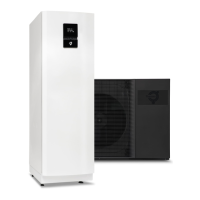4.3.7 Recovery of refrigerant
▪
When removing refrigerant from the system for servicing or decommissioning, it is recommended to remove the entire refrigerant.
▪
When transferring refrigerant into cylinders, make sure that only the refrigerant recovery cylinders are used.
▪
All cylinders used for the recovered refrigerant shall be labelled.
▪
Cylinders shall be equipped with pressure relief valves and shut-off valves in a proper order.
▪
The recovery system shall operate normally according to the specified instructions and shall be suitable for refrigerant recovery.
▪
In addition, the calibration scales shall operate normally.
▪
Hoses shall be equipped with leak-free disconnect couplings.
▪
Before starting the recovery, check for the status of the recovery system and sealing state. Consult with the manufacturer if unsure.
▪
The recovered refrigerant shall be returned to the supplier in the correct recovery cylinders with the Waste Transfer Note attached.
▪
Do not mix refrigerants in the recovery units or cylinders.
▪
If compressors or compressor oils are to be removed, make sure that they have been evacuated to the acceptable level to ensure
that flammable refrigerant does not remain in the lubricant.
▪
The evacuation process shall be performed before sending the compressor to the suppliers.
▪
Only the electrical heating to the compressor body is allowed to accelerate the process.
▪
Oil shall be drained safely from the system.
▪
Never install a motor-driven equipment (to prevent ignition).
4.3.8
Drain work
Caution Make sure that the condensed water runs well out of the outdoor unit
at low ambient temperature. Drain pipe and heat exchanger can
frost/ice can not grow. If drain work is not effective for releasing con-
densed water, it can make the units get damaged by massive ice and
system can be stop , covered by ice.
When operating the unit in a low outdoor ambient temperature, be
sure to follow the instructions described below.
Caution If drain work is not adequate, it can lead to system performance degra-
dation and system damages.
General area
While the heat pump is operating in heating mode, ice can begin to accumulate on the surface of the heat exchanger. To prevent ice
from growing, the system goes into defrost mode and the ice on the surface turns to water. Dripping water from condenser must there-
for be guided through running drain holes, to prevent ice growing at low temperature.
▪
In case there isn't enough space for drainage out of the unit, additional drain work are required. Follow the description as below.
▪
Make space more than 400mm (in cold climate zones and 100 mm in average climate zones) between the bottom of the outdoor
unit and the ground for installation of the drain hose.
▪
Connect the drain hose to the drain plug.
▪
Make sure the drain hose stays free from dust and small branches
Installation Guide
iTec XT
AWIXT01IG0102 Thermia AB
28

